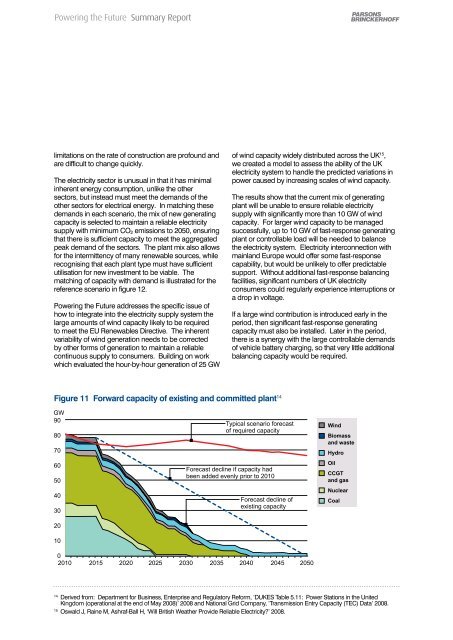Powering the Future Summary Report - Parsons Brinckerhoff
Powering the Future Summary Report - Parsons Brinckerhoff
Powering the Future Summary Report - Parsons Brinckerhoff
You also want an ePaper? Increase the reach of your titles
YUMPU automatically turns print PDFs into web optimized ePapers that Google loves.
<strong>Powering</strong> <strong>the</strong> <strong>Future</strong> <strong>Summary</strong> <strong>Report</strong><br />
<strong>Powering</strong> <strong>the</strong> <strong>Future</strong> <strong>Summary</strong> <strong>Report</strong><br />
limitations on <strong>the</strong> rate of construction are profound and<br />
are difficult to change quickly.<br />
The electricity sector is unusual in that it has minimal<br />
inherent energy consumption, unlike <strong>the</strong> o<strong>the</strong>r<br />
sectors, but instead must meet <strong>the</strong> demands of <strong>the</strong><br />
o<strong>the</strong>r sectors for electrical energy. In matching <strong>the</strong>se<br />
demands in each scenario, <strong>the</strong> mix of new generating<br />
capacity is selected to maintain a reliable electricity<br />
supply with minimum CO 2 emissions to 2050, ensuring<br />
that <strong>the</strong>re is sufficient capacity to meet <strong>the</strong> aggregated<br />
peak demand of <strong>the</strong> sectors. The plant mix also allows<br />
for <strong>the</strong> intermittency of many renewable sources, while<br />
recognising that each plant type must have sufficient<br />
utilisation for new investment to be viable. The<br />
matching of capacity with demand is illustrated for <strong>the</strong><br />
reference scenario in figure 12.<br />
<strong>Powering</strong> <strong>the</strong> <strong>Future</strong> addresses <strong>the</strong> specific issue of<br />
how to integrate into <strong>the</strong> electricity supply system <strong>the</strong><br />
large amounts of wind capacity likely to be required<br />
to meet <strong>the</strong> EU Renewables Directive. The inherent<br />
variability of wind generation needs to be corrected<br />
by o<strong>the</strong>r forms of generation to maintain a reliable<br />
continuous supply to consumers. Building on work<br />
which evaluated <strong>the</strong> hour-by-hour generation of 25 GW<br />
of wind capacity widely distributed across <strong>the</strong> UK 15 ,<br />
we created a model to assess <strong>the</strong> ability of <strong>the</strong> UK<br />
electricity system to handle <strong>the</strong> predicted variations in<br />
power caused by increasing scales of wind capacity.<br />
The results show that <strong>the</strong> current mix of generating<br />
plant will be unable to ensure reliable electricity<br />
supply with significantly more than 10 GW of wind<br />
capacity. For larger wind capacity to be managed<br />
successfully, up to 10 GW of fast-response generating<br />
plant or controllable load will be needed to balance<br />
<strong>the</strong> electricity system. Electricity interconnection with<br />
mainland Europe would offer some fast-response<br />
capability, but would be unlikely to offer predictable<br />
support. Without additional fast-response balancing<br />
facilities, significant numbers of UK electricity<br />
consumers could regularly experience interruptions or<br />
a drop in voltage.<br />
If a large wind contribution is introduced early in <strong>the</strong><br />
period, <strong>the</strong>n significant fast-response generating<br />
capacity must also be installed. Later in <strong>the</strong> period,<br />
<strong>the</strong>re is a synergy with <strong>the</strong> large controllable demands<br />
of vehicle battery charging, so that very little additional<br />
balancing capacity would be required.<br />
Table 5 Potential major power plant types for installation in <strong>the</strong> UK to 2050<br />
Figure 11 Forward capacity of existing and committed plant 14<br />
14<br />
Derived from: Department for Business, Enterprise and Regulatory Reform, ‘DUKES Table 5.11: Power Stations in <strong>the</strong> United<br />
Kingdom (operational at <strong>the</strong> end of May 2008)’ 2008 and National Grid Company, ‘Transmission Entry Capacity (TEC) Data’ 2008.<br />
15<br />
Oswald J, Raine M, Ashraf-Ball H, ‘Will British Wea<strong>the</strong>r Provide Reliable Electricity?’ 2008.<br />
31:32

















